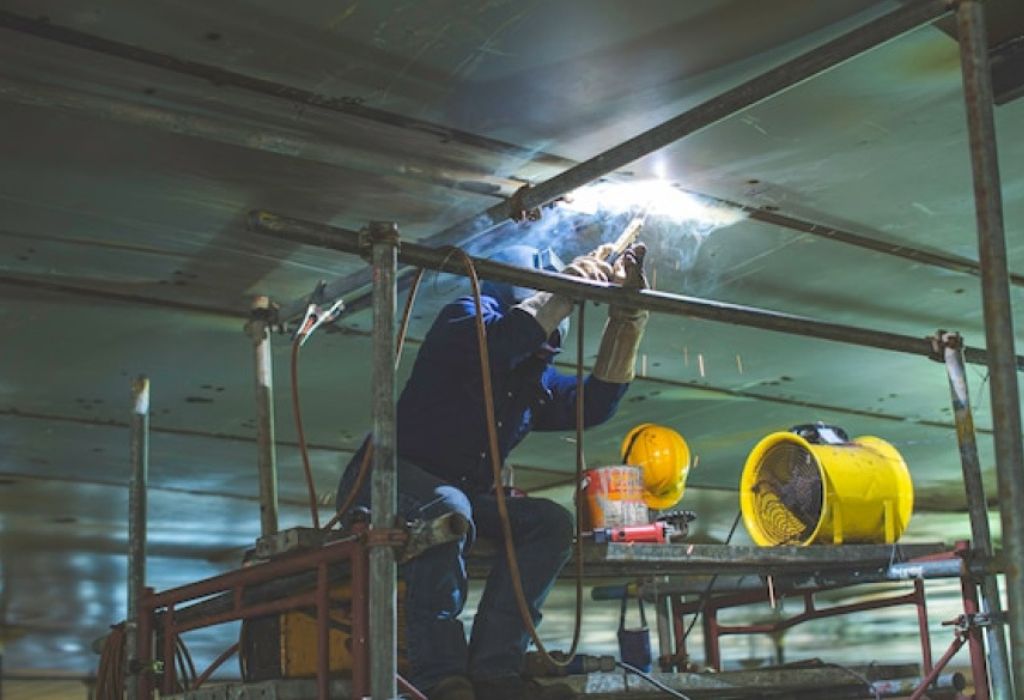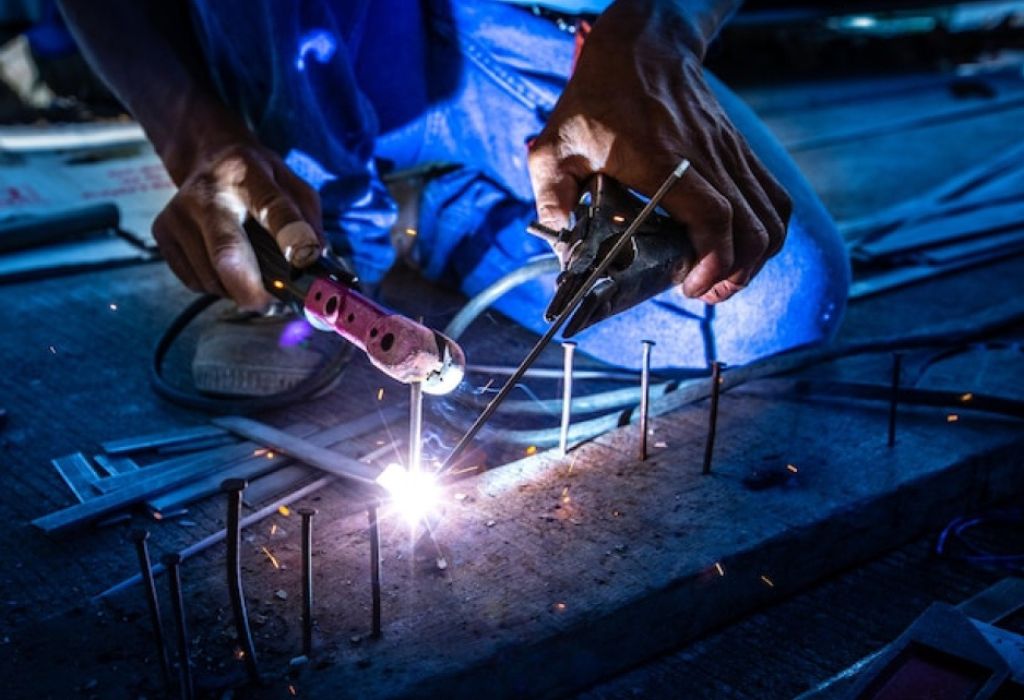In a bustling welding shop, the sharp crackle of sparks and the flash of molten metal can look impressive — but they also hide serious dangers.
Without the right barriers in place, invisible UV and IR radiation from a welding arc can travel across the room, causing eye burns, skin damage, or even fires.
This is why professionals never work without welding curtains, the unsung heroes of industrial safety.
Every year, the Occupational Safety and Health Administration (OSHA) reports thousands of welding-related injuries, many caused by improper shielding and exposure to harmful light.
A study by the American Welding Society found that over 60% of workplace eye injuries in welding environments happen to people not directly involved in the welding process, but nearby.
That statistic alone highlights why welding curtains are more than just accessories — they are essential safety equipment.
Welding curtains create a controlled, enclosed workspace that keeps sparks, spatter, and radiation from spreading beyond the welder’s zone.
They help maintain visibility for the welder while protecting everyone else from dangerous light exposure.
By forming physical and visual barriers, these flame-resistant sheets also help reduce noise, improve workflow, and comply with OSHA and ANSI safety standards.
In this guide, you’ll discover why welding curtains are used in every welding environment, how they work, and the real science behind their protective design.
From material types to color codes and safety benefits, we’ll break down everything you need to know to keep your workspace compliant, efficient, and safe for everyone inside.
What Are Welding Curtains and How Do They Work?

Walk into any fabrication shop, and you’ll notice bright-colored panels or hanging sheets surrounding welding stations — those are welding curtains.
They’re more than just visual dividers; they’re a crucial layer of safety between a live welding arc and everyone nearby.
These curtains are specifically engineered to block intense light, sparks, and heat generated during welding operations.
Unlike ordinary plastic sheets, welding curtains are made of special PVC or vinyl-coated materials that resist fire and absorb radiation.
They’re designed to meet international safety standards such as EN1598, ensuring they effectively filter ultraviolet (UV), infrared (IR), and visible blue light.
The goal is simple — to let enough light through for supervision and safety monitoring while shielding harmful rays from nearby workers.
Color also plays a vital role in how welding curtains function.
Amber, green, red, and bronze each offer varying levels of light filtration, letting you balance visibility with protection depending on the welding process.
For example, darker colors like green or bronze are used for MIG and arc welding, while lighter shades such as yellow or amber are ideal for low-amperage work.
High-quality curtains also have anti-static and chemical-resistant coatings, ensuring they remain durable in harsh industrial environments.
They can withstand heat, sparks, and minor contact with molten spatter without catching fire.
These properties make welding curtains a practical, long-lasting solution for both small workshops and large industrial facilities.
What material are welding curtains made of?
They are crafted from flame-retardant PVC or vinyl that resists heat and filters radiation.
Why are they tinted or semi-transparent?
The tint reduces glare and filters out dangerous light without blocking all visibility.
Are all welding curtains fireproof?
No — they are flame-resistant, meaning they self-extinguish when the ignition source is removed.
Do colors indicate different protection levels?
Yes. Darker shades block more light and radiation, while lighter shades offer greater visibility.
How long do welding curtains last?
With proper care, they can last 3–5 years, depending on frequency of use and exposure.
Why Are Welding Curtains Important in a Welding Environment?
Welding curtains do far more than create privacy or mark a workstation.
Their main purpose is protection — for welders, co-workers, and even equipment nearby.
Without proper shielding, the flash from welding arcs can cause serious “arc eye” or photokeratitis, a painful condition similar to sunburn on the cornea.
The intense brightness of a welding arc can also permanently damage retinas if someone glances at it without protection.
Curtains filter these harmful rays, allowing safe supervision without risk.
They also stop sparks and molten spatter from flying into adjacent work areas or flammable materials.
In environments where multiple welders work side by side, curtains prevent visual interference between stations.
They also act as a noise barrier, softening the harsh sounds of grinding and welding tools.
By keeping fumes, dust, and debris contained, they help maintain better air quality and organization within a workspace.
Do welding curtains protect against UV and IR radiation?
Yes, they block up to 99% of harmful UV and IR radiation, protecting eyes and skin.
Can welding curtains stop sparks from spreading?
Absolutely. They contain sparks and molten spatter, preventing injuries and fire hazards.
Do welding curtains help control noise?
Yes, thicker curtains reduce noise levels by absorbing sound and vibration.
Are they required by OSHA?
Yes. OSHA mandates visual protection from welding arcs under 29 CFR 1910.252(b)(2).
Can they protect nearby machinery too?
Yes, they prevent sparks from damaging tools, vehicles, and electronic equipment.
Different Types of Welding Curtains
Not all welding curtains are the same.
They vary by design, color, and mounting style, depending on the type of welding and work environment.
- Stationary Curtains:
Mounted on frames or walls, ideal for permanent welding booths or fixed stations. - Portable Curtains:
Attached to movable frames with wheels, perfect for workshops that need flexible setups. - Strip Curtains:
Made of overlapping PVC strips that provide access while maintaining protection. - Auto-Darkening Screens:
Used in high-tech environments; automatically adjust opacity based on light intensity.
Color differences are just as important.
Amber curtains are ideal for low-amperage TIG welding, while dark green or bronze suits high-intensity arc welding.
Some manufacturers also offer custom-colored or multi-layered curtains for mixed-use facilities.
Which type of curtain is best for small workshops?
Portable curtains are ideal for small or mobile welding setups.
What’s the advantage of strip curtains?
They allow easy access without compromising protection.
Are darker curtains always better?
Not always. Choose based on welding type and visibility needs.
Can you combine different curtain types?
Yes. Many workshops mix stationary and strip curtains for flexibility.
Do all curtains meet the same safety standards?
No. Always check for EN1598 or ANSI Z87.1 compliance before buying.
How to Properly Use and Maintain Welding Curtains
Using welding curtains correctly is just as important as owning them.
Improper installation or poor maintenance can compromise their effectiveness.
Start by ensuring your curtain completely encloses the welding area, leaving no gaps for light or sparks to escape.
Position them at least 12 inches from the work surface to avoid direct heat damage.
Regular inspection is key — look for burns, cracks, or discoloration that might reduce their filtering ability.
Clean curtains with mild soap and water, avoiding harsh solvents that can degrade flame resistance.
When not in use, roll them up or hang them properly to prevent creasing.
If your workspace experiences heavy use, consider replacing curtains every 2–3 years or when they show signs of wear.
How often should welding curtains be cleaned?
Once a month for general use, or more frequently in dusty environments.
What’s the best way to repair small burns or holes?
Use manufacturer-approved repair patches or replace the panel if damage is extensive.
Can you cut welding curtains to fit a custom space?
Yes, but only using heat-sealed edges to maintain flame resistance.
Do welding curtains need certification labels?
Yes. OSHA and ANSI standards require visible compliance markings.
Should curtains be replaced after a fire incident?
Yes, even if they appear intact — heat exposure can weaken protection.
Welding Curtain Safety Standards and Regulations
Safety compliance isn’t optional — it’s mandatory for any professional workspace.
Curtains must meet or exceed safety certifications to ensure protection.
The EN1598 standard (Europe) and ANSI Z87.1 (U.S.) define the transmission levels for UV, IR, and visible light that curtains can allow.
These regulations ensure curtains reduce radiation exposure while still allowing visibility.
OSHA requires that all personnel not engaged in welding but within range must be shielded from arc rays.
Employers are responsible for ensuring curtains are properly installed and maintained to meet these standards.
What does EN1598 certification mean?
It guarantees the curtain’s ability to absorb radiation and resist flame spread.
Is ANSI Z87.1 the same as OSHA compliance?
They complement each other — ANSI defines testing, OSHA enforces usage.
Can uncertified curtains be used temporarily?
No, uncertified materials pose serious safety risks and legal liability.
Do welding booths also require curtains?
Yes, even booths use curtains or screens to control reflection and glare.
How can you verify curtain compliance?
Check product labels or request a certificate of conformance from the supplier.
Benefits of Using Welding Curtains

Beyond protection, welding curtains offer a range of practical advantages.
They improve overall workflow, efficiency, and professional appearance.
- Enhanced Safety: Blocks harmful rays, sparks, and heat.
- Increased Productivity: Creates defined work zones, reducing interference.
- Better Air Quality: Containment helps fume extraction systems work efficiently.
- Cost Savings: Reduces accident-related downtime and damage to equipment.
- Compliance: Ensures your workplace meets OSHA and ANSI standards.
Do welding curtains help with energy efficiency?
Yes, they help regulate temperature by containing heat in one area.
Can they be used outdoors?
Yes, with UV-stabilized materials designed for outdoor conditions.
Do curtains add privacy for welders?
Yes, they provide visual separation while maintaining visibility for supervisors.
Can welding curtains improve ventilation?
Indirectly — they isolate fumes, allowing extraction systems to perform better.
Are they worth the investment for small shops?
Absolutely. They protect workers, save money, and extend tool lifespan.
Conclusion
Welding curtains aren’t just colorful barriers — they are essential safety tools that protect welders, coworkers, and equipment from the invisible dangers of welding.
They block UV and IR radiation, stop sparks, reduce noise, and help maintain compliance with global safety standards.
Whether you’re managing a large fabrication facility or running a small garage workshop, investing in high-quality welding curtains ensures a safer, cleaner, and more professional environment.
A few panels of fire-resistant PVC can make the difference between a well-run operation and a serious accident.
So the next time the sparks fly, make sure there’s a curtain between you and the danger — because true welding safety starts with proper shielding.

I’m Darrell Julian, the founder, lead writer, and hands-on welding enthusiast behind ArcWeldingPro.com. With more than 15 years of real-world welding experience, I created this platform to share what I’ve learned in the field, in the shop, and in the heat of the arc.


